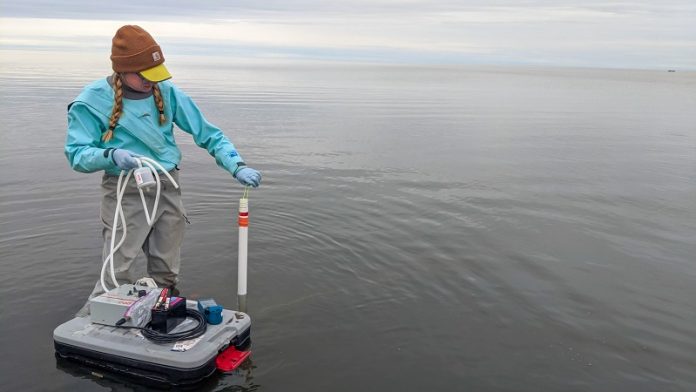
New research has found that groundwater in the Arctic is releasing large amounts of carbon into the ocean—much more than scientists previously thought.
Even though only a small amount of groundwater flows through Alaska’s tundra, it is carrying about 230 tons of organic carbon into the ocean each day during the summer.
This is similar to the amount of carbon released by rivers in the same area.
The study was led by Cansu Demir, a scientist who completed her doctoral research at The University of Texas at Austin.
The findings, published in Geophysical Research Letters, show that fresh groundwater flowing beneath the tundra is an important source of carbon to the ocean.
Groundwater moves underground through soil and sediments, collecting organic matter, nutrients, and other materials along the way. When it reaches the ocean, it releases these materials into the water.
In the Arctic, permafrost—frozen soil that stores large amounts of carbon—plays a big role in this process.
As permafrost melts due to rising temperatures, it releases stored carbon into the groundwater, which then carries it into the sea.
The study found that fresh groundwater flowing into the Beaufort Sea, north of Alaska, makes up 3–7% of the total summer water discharge from three major rivers in the region.
While this may seem like a small amount, it carries nearly the same amount of organic carbon as the much larger rivers. This was surprising to scientists because Arctic groundwater was previously thought to have little impact on the ocean’s carbon levels.
Carbon in the ocean can lead to higher levels of carbon dioxide (CO₂) in the air, which contributes to climate change. The CO₂ released from groundwater might also increase ocean acidification, making seawater more acidic. This can harm marine life, especially creatures like crabs, clams, and snails, which rely on calcium to build their shells.
“As permafrost thaws, it turns into coastal and submarine aquifers,” said Bayani Cardenas, a co-author of the study. This means that melting permafrost is creating new pathways for groundwater to flow into the ocean, carrying more and more carbon with it.
Before this study, scientists thought that very little fresh groundwater flowed into the Arctic Ocean. Most past studies focused on saltwater that had seeped into the ground from the sea. This new research is the first to directly observe and measure fresh groundwater discharge in this region.
With climate change causing faster permafrost thaw, scientists expect even more freshwater will flow underground into the ocean in the future, bringing larger amounts of carbon and greenhouse gases with it. This could accelerate climate change and have major effects on Arctic ecosystems.
“The Arctic coast is changing in front of our eyes,” said Cardenas. Researchers now plan to study how this hidden carbon flow will continue to impact the climate and ocean life in the years to come.
Source: University of Texas at Austin.



